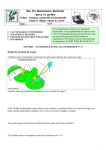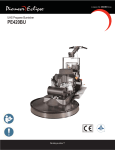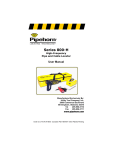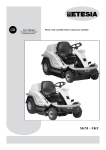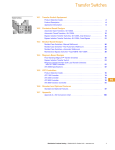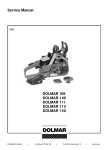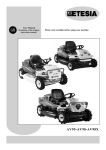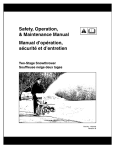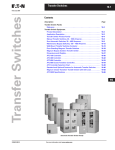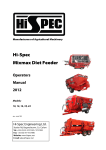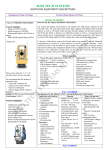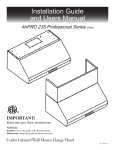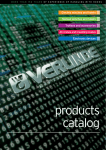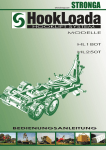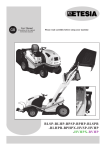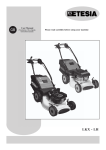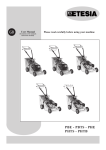Download Etesia Bahia 2 owners operators manual instrucion book UK version
Transcript
GB User Manual Please read carefully before using your machine (Translation of the originals instructions manual) MBHE2-MKHP3-MHHE2MKHE3-MKM OPERATING AND MAINTENANCE MANUAL FOR THE RIDE-ON MOWER ETESIA CONTENTS 2 1. Your safety and that of others ....................................................................................................................................................... 3 2. Key to diagrams ............................................................................................................................................................................ 5 3. Description .................................................................................................................................................................................... 9 4. Pictures ....................................................................................................................................................................................... 11 5. Pictures - Accessories in option .................................................................................................................................................. 19 6. Specifications .............................................................................................................................................................................. 21 7. Operating instructions ................................................................................................................................................................. 23 8. Assembly - Disassembly - Access to components ...................................................................................................................... 26 9. Maintenance ................................................................................................................................................................................ 27 10. Maintenance schedule ................................................................................................................................................................. 31 11. Prolonged storage - Winter storage............................................................................................................................................. 32 12. Troubleshooting .......................................................................................................................................................................... 32 13. Accessories ................................................................................................................................................................................. 33 14. Warranty...................................................................................................................................................................................... 34 C ONGRATULATIONS ! You are now the proud owner of an Etesia ride-on mower. This extremely reliable and tough machine has been specially designed to give many years of service. • In order to prolong the life of your mower and keep it in excellent working order, read this manual carefully and always follow the safety recommendations and maintenance instructions. • As part of our commitment to excellence, we are constantly seeking new ways of improving our products. • For this reason, your model may differ slightly from the description in this manual. • Up-to-date technical information can be obtained from your dealer. • He will be happy to resolve any queries you may have. MOWER IDENTIFICATION • EVERY MODELS EXCEPT MKM: The identification number of your mower is located on the right-hand side of the machine next to the grass box (see picture 1a). • MKM: The identification number of your mower is located under the seat (see picture 1b). • Always quote this number when seeking advice from your dealer. 1• YOUR SAFETY AND THAT OF OTHERS • Always follow these instructions when using your ride-on mower. • Prior to use, check that safety labels are present on the mower as indicated in the manual. Read these labels carefully. If any safety labels are missing, inform your dealer immediately, as the mower is required by law to carry them. • Never remove warning labels or safety instructions. • Before using your mower, make sure that you are completely familiar with the controls • Study the operating instructions so that you are able to stop the machine quickly. • Always keep the mower and accessories in good working order. • Never operate the mower using faulty guards or without the use of safety devices. • Do not attempt to adjust the engine speed controls. • Never race the motor as this will increase the risks of injury to the operator and the likelihood of damaging the components of your lawn mower. • Never allow your mower to be used by anyone who is not familiar with the operating manual. • Never use your mower on slopes with a gradient of more than 10° (17,6%). • Always observe the special instructions concerning use of the mower on sloping ground. • Never drive your mower too close to embankments or ditches, on soft ground, or where there is a risk of overturning. • The user is responsible for ensuring the safety of others within the area where the mower is being used. • Keep a safe distance from people and animals when the engine is running. • Never allow passengers to ride on the mower. • Never allow children under the age of 16 to drive the mower. • Always remove the ignition key when leaving the mower unattended, even momentarily. • Before using the mower, always check the condition and adjustment of the blade. • Never attempt to carry out work on or underneath the mower if it has been raised on temporary supports or without taking proper safety precautions. • Before mowing, always clear the lawn of stones, pieces of wood or metal, wire, bones, plastic, branches and other debris liable to be thrown out by the mower. • Make sure that your lawn has no natural barriers of the type molehills, cracks, ruts... • Low branches liable to cause injury to the user should also be removed. • Avoid obstacles such as mole hills, concrete pedestals, tree stumps and edging, which cannot be cut by the blade and which could damage the cutting mechanism specially the blade. • Change absolutely the blade after any shock. • Exercise particular care when reversing. • The advance control is a maintained-action safety device: never lock it. Never put your foot astride the two pedals. • Never place hands or feet under the cutter housing. • Whilst mowing, take care to avoid injury to others caused by flying stones and other objects. • Operate the mower only in broad daylight or with good artificial lighting. • Loose clothing and short trousers should not be worn when using the mower. • Always wear stout and closed shoes. • When adjusting the engine or moving parts, always switch off the engine and remove the ignition key. As a precaution, disconnect the spark plug caps. • Never operate the machine when feeling tired or unwell. • Never operate the machine after consuming alcohol or taking medicine. • When the mower is driven on surfaces other than grass, disengage the cutter and switch it to the fully raised position. • Do not fill the tank whilst the engine is running. Allow the engine to cool for few minutes before filling. • Always use recently purchased petrol. Old petrol will leave gum deposits in the carburattor, lead or leacks or make the engine difficult to start. Only buy as much unleaded petrol as is required for less than one month. Store the petrol in a clean container which is not used for other purpose. • WARNING: fuel is highly flammable. - Always fill the fuel tank in the open and do not smoke during this operation. - Add fuel before starting the engine. Never remove the fuel cap whilst the engine is running or hot. - Avoid fuel overflow while filing the fuel tank. If in spite of these precautions it should happen, check following : a) Clean scrupulously all the contaminated parts. b) Don’t start the machine as long as you’re not sure that all spilled fuel has been eliminated. • Ensure that the fuel tank and fuel can caps are replaced correctly. • Never store, pour or use petrol near a naked flame or near devices such as stoves, water-heaters with pilot lights or any other device liable to produce sparks. • WARNING: NEVER ALLOW THE ENGINE TO RUN IN CONFINED AREAS. Exhaust gases contain carbon monoxide, which is odourless and can kill. • Do not start the engine if you can smell petrol, or in the presence of other risks of explosion. • Do not run the motor without a silencer. • Examine the silencer regularly and replace as required. • Clean the silencer and surrounding area regularly to prevent the accumulation of grass and other flammable materials. Please cool the engine a few minutes before you clean the exhaust. • These precautions are vital to your safety. However, the recommendations given are not exhaustive and due care should always be exercised when using your mower. 3 1• YOUR SAFETY AND THAT OF OTHERS • You should also comply with any legal requirements relating to ride-on mowers (e.g. insurance, useful life, etc). • The mower is not designed for towing. • If the machine has to be lifted or transported, turn off the motor and close the petrol tap. • It is better to use a loading ramp to load or unload the machine. INSURING YOUR RIDING MOWER: Under the terms of articles L 211-1 and the following, R 211-1 and the following, and A 211-1 and the following of the Insurance Code, it is mandatory to ensure all motor-driven land vehicles. Your riding mower is not homologated for the use of the public highway which is therefore prohibited to it. You should not use this mower until you have read the safety instructions with care. Read this instructions manual carefully for the use and maintenance of your mower. SERVICING • Always keep the machine and its accessories in perfect operating condition. • Replace worn or damaged parts for greater safety. • Replace immediately the exhaust silencer if it is defective. • Servicing and cleaning work on the mower must only be carried out with the engine turned off. As a precaution, disconnect the spark plug caps. • It is highly unadvisable to use a high pressure cleaner at the risk of damaging certain parts. • Spare blades must only be fitted to mowers for which they are designed, in conformity with the indications given. • After an impact on a blade, it must be replaced. 4 RESPONSIBILITY • In the event of failure to use the mower in conformity with the instructions manual and the applicable regulations, ETESIA cannot accept any responsibility. • You must not make any modifications to your mower without the prior agreement of ETESIA. Any modification not authorised by ETESIA can make the machine dangerous and lead to severe injury in use. In the event of failure to comply with these instructions ETESIA cannot accept any responsibility. 2• KEY TO DIAGRAMS - SAFETY • LABELS • Various labels have been affixed to your mower. • Check that they are all present (see list below and pictures 1, 2 and 3). • Labels with a yellow background warn against risks. • The other labels contain instructions for operating the mower. This symbol appears in the instruction manual alongside those sections which deal with user safety. This symbol appears in the instruction manual alongside important information on how to prolong the life of your mower. • ENGINE DIAGRAMS Fuel is highly explosive and inflammable. Stop the engine before fill the fuel tank. DO NOT SMOKE. Always fill the fuel tank in the open and never pour or use petrol near a naked flame or near devices such as stoves, water-heaters with pilots lights or any other deviceiable to produce sparks. Exhaust fumes are very toxic and contain carbone monoxide who is a deadly and odourless poison. Do not run the engine in confined areas. To avoid any burn, do not touch the exhaust pipe when it is hot. • SAFETY LABELS DIAGRAMS RECTANGLE A (PICTURE 3) DIAGRAMS RECTANGLE C (PICTURE 2) • a = CAUTION ! • DANGER! • b = Before using, please read and follow the safety and maintenance instructions of the instruction booklet. • a = Risk of cutted feet and hands. • c = Stop the engine, disconnect the spark plug and remove key from ignition before proceeding to any maintenance operation. • d = Risk of projections. • b = Hold the third persons far from the machine. MARKING OF ACCUMULATORS • e = Avoid the presence of third persons in the danger zone. • a = Indicates these are hazardous products which should preferably be returned to the distributor. • f = Fall down risk. Never transport passengers. • b = (Pb) indicates the presence of lead. • g = Hold the third persons far from the machine. • h = Risk of toppling over the machine. • i = Never use your ride on mower on slopes with a gradient of more than 17,6 % (10°). DIAGRAMS RECTANGLE B (PICTURE 3) • a = Risk of cutted feet and hands. • b = Hold the third persons far from the machine. • c = Risk of objects projection and cutted feet. • d = Never use the mower without the flap. Never open the flap of the cutting box by running engine. Before each use, check that the flap is locked or the rear charge deflector is put in place. 5 2• KEY TO DIAGRAMS - SAFETY 1a a Rectangle C 2 1b 3 Rectangle A Rectangle B 6 2• KEY TO DIAGRAMS - SAFETY Rectangle A Rectangle B Rectangle C a b Marking of accumulators a b 7 2• KEY TO DIAGRAMS - USE • With the option MVE80, the grass box emptying is done by electrical ram controlled by a switch. • ENGINE SPEED • Indications for controlling engine speed: START : position for starting the engine MAXI : engine at full speed MINI : engine idling CLOSING THE BOX OPENING THE BOX • STARTING THE ENGINE • OPERATING THE CUTTER 0 : engine off, power switched off I : power switched on I : cutter switched on : engine started 0 : cutter switched off • PARKING BRAKE • BY-PASS • The arrow indicates the direction of movement of the brake lever in order to engage the parking brake. 1 : Lever on I position : closed by pass = advance transmission engaged 0 : Lever on O position : open by pass = advance transmission disengaged • CUTTING HEIGHT • LIGHTING (MKHP) • Indicates the cutting height. • HORN (MKHP) • EMPTYING THE GRASS BOX • On every models except MKM : The arrow indicates the direction of movement of the release lever in order to empty the grass box. 8 3• DESCRIPTION 1 2 4 3 5 12 7 8 14 6 13 15 11 9 • 1. Fuel cap • 2. Parking brake lever • 3. Cutting height lever • 4. Emptying grass box lever (except on MKM) • 5. Engine speed adjusting lever • 6. Seat lever • 7. Forward pedal • 8. Reverse pedal 10 • 9. Inspection flap • 10. Ornamental hub cap front wheels • 11. Ornamental hub cap rear wheels • 12. Front light (MKHP) • 14. Strap hook • 15. Grass box bonnet • 16. Central bonnet 9 3• DESCRIPTION DASHBOARD 1 2 5 4 7 3 • 1. Cutting deck switch • 2. Grass box opening and closing switch (option MVE80) • 3. Hour meter - Tachometer (MKHP) • 4. Audible warning device control switch (MKHP) 10 6 • 5. Lights control switch (MKHP) • 6. Key switch • 7. 12V charger connector (option MCB) 4• PICTURES STOP 4 MBHE - MKHE MHHE - MKM MKHP 5 5a 6 7a 10° (17,6 %) 7b 8 11 4• PICTURES 13 9 a 10 13a a 11 12 12 13b 14a 4• PICTURES 14b 18 2 1 15 19 20 16 17 2 1 21 13 4• PICTURES HONDA 23 22 BRIGGS & STRATTON 24a c HONDA GXV 390 24b BRIGGS & STRATTON 25 14 KAWASAKI FS481V 24c BRIGGS & STRATTON 4• PICTURES HONDA GXV 390 25a 28a a b c KAWASAKI FS481V 25b HONDA GXV 390 28b KAWASAKI b 26 a c b d KAWASAKI FS481V a 27 28c 15 4• PICTURES 29a 29b BRIGGS & STRATTON HONDA 30a 31 16 KAWASAKI 30b 32 4• PICTURES MAXI MINI 33 36b MC85MN 36c 34 a 37a 35 36a 37b 17 4• PICTURES 38b 38a 39 40 18 4• PICTURES - ACCESSORIES IN OPTION MU80N MD80N 41 42 MCB MAC 44 43 MR80 MET 45 46 19 4• PICTURES - ACCESSORIES IN OPTION MRM 47 MVE80 MV80N 49 MN80 48 50 20 21 240 liters Grass box capacity Not cutted radius Dynamic breake Hydraulic with advance transmission 0,7 m Front : 10x6.5-6 Rear : 16x6.5-8 0 - 9 km/h Foward speed Tyre sizes Hydrostatic Transmission MOWER 6-8h Autonomy 2850 ± 100 1,1 l 12 liters 1,4 l Paper element + polyuretahne foam filter Fuel tank capacity Rate Oil sump capacity Motor air filter Fuel filter (ref: 25266) Paper filter Super grade unleaded fuel Front : 13x5.0-6 Rear : 16x6.5-8 1,5 l - 1,7 l with filter Ref : 18363 Front :10x6.5-6 Rear : 16x6.5-8 Ø 3000 ± 100 Ref : 03861 12V - 15A with rectifier Under pressure by pump Standard Ø 14 mm x 19 mm Fuel type Motor oil filter MKM 16 HP (11,9 kW) at 3600 rpm 603 cm3 Twin cylinder air-cooled 73 x 72 mm KAWASAKI FS481V MKHP Ref : ZY751 or 3861 MKHE Standard Ø 14 mm x 19 mm 0,75 mm Standard Ø 14 mm x 19 mm Spark gap Spark plug Electric 12V Starter 12V - 10A with rectifier By oil pump 13 HP (9,6kW) at 3600 rpm 389 cm 3 88 x 64 mm 12V - 20 Ah 12V - 9A with rectifier By oil turbine Without Single cylinder air-cooled 15,5 HP (11,4 kW) at 3600 rpm 502 cm 3 91 x 78 mm 4 stroke OHV MHHE HONDA GXV390 MBHE BRIGGS & STRATON INTEK 31E607 Battery Alternator Lubrification Power Cubic capacity Cylinder / Cooling Bore / Stroke Type Engine MODEL 6• TECHNICAL SPECIFICATIONS 22 MODEL Steel No Central steering 5 positions 80 cm Electromagnetic with built-in blade brake 80 cm Hanging cutting deck 230 Kg 1,47 m/s² maxi 0,66 m/s² maxi 1,17 m/s² maxi 1,12 m/s² maxi 1,17 m/s² maxi 1.4 awx 1.4 awy awz A (8) Directive 2002/44/CE Reference standards : ISO2631-1, ISO5349-1+2 A (8) ahw 86 dB (A) Switches on grassbox / seat / neutral position / parking brake ahw Daily exposure value MHHE Mechanical, mounted on hydrostatic box 1975 x 825 x 1210 mm Seat vibration level (full body) MBHE Directive 2006/42/EC Reference standards : EN836, EN1032, EN1033 VIBRATIONS Sound pressure at driver’s seat SAFETY SYSTEM Anti scalp protection Cutting height Cutting width Blade clutch Blade Type of mounting Cutting deck CUTTING SYSTEM Dimensions L x w x H Weight Parking breake 6• TECHNICAL SPECIFICATIONS Yes 1995 x 825 x 1300 mm 240 Kg MKHP 2,1 m/s² maxi 2,1 m/s² maxi Handlebar vibration level (other appendages) 1975 x 825 x 1210 mm MKHE Switches on seat / neutral position / parking brake Yes 85 cm 85 cm Mastershock 1730 x 900 x 1220 mm 220 Kg MKM 7• OPERATING INSTRUCTIONS 7•1 PRE-DELIVERY INSPECTION • The pre-delivery inspection of your mower is a highly technical operation and will therefore be carried out by your approved dealer/ repairer. 7•2 SAFETY SYSTEMS • The mower is fitted with 4 safety switches which are activated by : - 1. the control pedals - 2. the seat - 3. the grass box (except on MKM) - 4. the parking brake • The motor can only be started if the following conditions are satisfied : - the driver is seated or the parking brake is engaged - the control pedals are in the neutral position - the cutter is not switched on. • The motor is stopped automatically if the driver leaves the seat and: - either the cutting system remains engaged - or the parking brake is not applied. • The engine will also stop if the control pedals are operated whilst the parking brake is on. • The cutter can only be activated if : - the grass box is correctly closed - and the driver is seated. WARNING! The grass box opening provoke the stop of the cutting unit. The cutter unit will automatically start when the grass box comes back in working position. • In the event of a fault, do not attempt to use your mower. Contact your approved dealer/repairer. 7•3 FUEL CAUTION DANGER ! Petrol is highly inflammable. • For your engine we recommend that you use 95 unleaded fuel that you have acquired recently. Only buy the amount of petrol that you can use in 1 month and store it in a jerrican specially reserved for this purpose. • Do not add oil to the petrol ! WARNING ! Do not use additives or petrol/alcohol mixtures. • Always fill up outdoors and do not smoke when filling the tank. Avoid any flames or the projection of sparks. Avoid spilling petrol and be sure not to overfill the tank to prevent it overflowing : leave a space of approximately 5 cm under the filler spout to allow the fuel to expand. • When filling the tank, we advise the use of a funnel with a float. By means of its floating stem, this funnel indicates when the tank is full (see picture 4). When the tank’s full, take the funnel away by holding the top of the float rod (see 3 picture 4). • Put the tank and petrol feed caps back in place correctly. • If petrol has been spilled, when you smell it, or if there are any other explosive conditions, do not try to start the engine but clean all the parties concerned carefully and avoid causing ignition until the petrol vapours have dissipated. When draining the petrol tank, work outdoors (in the open air). 7•4 SEAT ADJUSTMENT • For safe driving, the position of the seat should be adjusted so that the pedals are within reach. • To unlock the seat, push the seat lever - towards exterior on MKHP. - towards interior on MBHE, MKHE, MHHE and MKM. • Move the seat to the required position. • Release the lever and check that the seat is locked in place. 7•5 TURNING THE ENGINE ON AND OFF 7•5•1 TURNING ON Before use, always carry out a visual check to make sure that the cutting blade and its attaching screw are not worn or damaged. • Before starting the engine, always check the engine oil level. Top up the oil if the level does not reach the mark [FULL] (see paragraph 9•3•1 and picture 24). The oil gauge must be screwed down home when the engine is running. • Also check the level of the hydraulic fluid in the expansion cylinder. The oil level must always be visible in the expansion cylinder (see paragraph 9•4•2). • Check the cleanliness of the air cooling inlet grille under the seat, the engine compartment and the hydrostatic axle cooling fins. Also regularly check the condition of the fan (see picture 29). • Top up with fuel in order not to have to add petrol during work when the engine is hot. • Open the petrol tap. • Take place on your mower seat. • Make sure that the cutting system selector is not engaged and that the advance pedals are not operated. • Turn the petrol control to the [START] position for cold starts. • Insert the ignition key and turn it to the right to the starting position ]. [ • When the engine has started, release the key and put the accelerator control between the [MINI] and [MAXI] positions. • Let the engine run for between 3 and 5 minutes before setting the accelerator control to the [MAXI] position and starting the cutting system. To restart a hot engine, set the accelerated control directly to the [MAXI] position and start the engine. The engine can only be started if the parking brake is applied and the cutting system selector is not engaged. CAUTION ! Never leave the engine running in closed areas where carbon monoxide, a dangerous substance, could build up. CAUTION ! Never remove the petrol cap or add petrol while the engine is running or when it is hot. Leave the engine to cool for 2 minutes before topping up with petrol. Do not change the original settings of the engine and do not let the engine race. In the event of maladjustment, contact your ETESIA dealership. 23 7• OPERATING INSTRUCTIONS 7•5•2 TURNING OFF THE ENGINE • Set the accelerator control to the [MINI] position then turn the ignition key to the left, bringing it to the off position [O]. • Close the petrol tap for extended periods of stoppage. CAUTION ! Never use the accelerator control [START] position to stop the engine. CAUTION ! Never leave the ignition key in the on position [I] when the engine is at a stop; the battery would discharge slowly and the hour meter would continue to run. Never leave your foot astride the two pedals. The position of the pedals governs the speed of movement of the mower from stationary (pedal not operated) to top speed (pedal pressed down all the way), as well as dynamic braking. • Release the pedal to reduce the speed of movement. • Lift your foot entirely off the forward pedals to come to a stop : the mower will brake gradually until it reaches a full stop. • To stop quickly, lift your feet off the pedals and apply the parking brake. CAUTION ! When you leave the mower unattended, remove the ignition key. 7•6 STARTING AND STOPPING THE CUTTER 7•6•1 STARTING THE CUTTER • Move the throttle hand-lever to the [MAXI] position. • Swing in [1] position the comutator located on the dashboard (see 1 description page 10). • The cutter can only be activated with the driver seated and the grass box in normal working position. 7•6•2 STOPPING THE CUTTER • To stop the cutter, move the switch to position [0]. The cutter will stop when the box opens and will only restart when the box returns to the normal closed position. • Stoppage of the engine caused by the driver leaving his seat will in turn stop the cutter. Always turn the cutting system off before leaving your seat. 7•7 DRIVING THE MOWER 7•7•1 PARKING BRAKE The parking brake locking lever is to the left of the seat. • To apply the parking brake, push the brake lever forwards then towards the inside of the machine; because of the spring loading, the lever will assume that the parking brake applied position. • To release the parking brake, push the brake lever forwards then engage it in its notches. Always apply the parking brake before getting out of your seat. To slow down your speed : control the forward speed with dynamic braking provided by the hydrostatic transmission by reducing the action on the forward travel pedal. 7•7•2 FORWARD CONTROL PEDALS 7•8 CUTTING HEIGHT ADJUSTMENT • To adjust the cutting height, use the lever situated on the left of the seat. • Push the lever down to lower the cutter and up to raise it. • Select a higher setting for long or wet grass (position 4 and 5). • Select lower settings (position 1, 2 and 3) for flat, regularly maintained lawns. 7•9 MOWING Before mowing, check the condition of the blade and its tightness. To obtain regular cutting, it is important to check whether the tire pressure is the recommended pressure (see paragraph 9•6). • The picture 6 illustrates the optimum method of using the mower on most lawns. • These instructions will enable you to avoid making sharp turns and unnecessary journeys. • When mowing with the cutter set low, it is important to select a low speed, to keep the engine at a high speed. 7•9•1 MOWING WITH GRASS COLLECTION (EXCEPT MKM) • When the grass box is full, an alarm will sound, switch off immediately the cutter. • By switching off the cutter the alarm is deactivated. • Empty the box. • The box is emptied from the driver’s seat. - With lever : to empty, lift this lever and drive slowly the machine before closing the grass box. - Option MVE80 : empty with the electric ram by swinging the opening and closing box comutator towards down, move slowly the machine before closing the box by swinging the same comutator towards the top. • To make collection of the grass easier after mowing, create two or three larger piles of grass rather than several smaller ones. • Because emptying the box is so quick and easy, there is no need to fill it completely. Empty the box, even if it is not completely full, whenever you come to an existing pile of grass. • This will save unnecessary journeys. The forward movement of your mower is controlled by the two pedals placed at the front of the right running board. 7•9•2 MOWING WITHOUT COLLECTING : MODEL MKM • Before making any movements, release the parking brake. • Operate the right hand pedal gradually to adjust the forward speed. • Gradually operate the left hand pedal to adjust the reverse speed. • Look at the mown area : there should be no cut grass left on the surface. If cut grass can be seen, the cutting height should be raised until the desired result is obtained. 24 7• OPERATING INSTRUCTIONS Advice for mulching 7•10 DRIVING ON SLOPING GROUND • It is better to mulch the grass when it is dry. Mowing wet or damp grass increases the amount of debris accumulated in the housing, results in clodding and requires more power. • Keep the blade housing clean. Accumulated debris under the housing reduces the shredding efficiency. • Only mow one third of the height of the grass at a time. Mow more than once if the grass is tall or wet. • Do not mow the same area more than once : - allow a greater overlap of cutting. - adjust the speed according to the condition of the grass. - the blades must be in perfect condition. Check them and sharpen them frequently. • The machine is suitable for use only on ground with a gradient of less than 17,6 % (10°) (see picture 8). • To ensure maximum safety when driving on slopes, follow the instructions below : - Avoid sudden stops. - Always drive at low speed so as not to lose control of the mower. - When moving off on a slope [uphill or downhill start], release the parking brake and move forward immediately using the control pedals. - Particular care should be taken when performing U-turns on sloping ground. Prepare for the change of direction and reduce speed so as not to lose control of the mower. - Apply the parking brake as soon as the mower stops. 7•9•3 HIGH GRASS MOWING Always stop the engine and take the key out of the ignition before modifying the open or closed deflector mowing mode. Choose the mowing mode before beginning to mow. OPTIONAL MD80 DEVICE (except MKM) • For mowing exceptionally high grass, a cutting deck lateral ejection device improves the efficiency of your mower. 7•11 SPECIAL EQUIPMENTS FOR DIFFERENT MODELS 7•11•1 LIGHTING (MKHP) In order to see and to be seen, your mower is fitted with front lights. Please switch the lighting control commutator on. • Use of grass box as deflector : - For mowing without picking up the grass, the bottom of the grass box can be removed. To unclip the bottom of the grass box, bring it to the dumping position (see picture 7a). 7•11•2 BUZZER (MKHP) MODEL MKM CAUTION ! In spite of these equipments, you are not allowed to drive on public roads with your machine. • When mowing tall grass, use the lateral ejection device built into the cutting deck. This improves the efficiency of your mower Opening/closing the deflector : • Undo the lateral deflector clasp on the right of the cutting deck. The deflector is deployed automatically outwards by a spring, and the protective flap is positioned in front of the lateral ejection outlet (see picture 7b). • Check that the protective flap is in position and in good condition. Do not use your mower in the lateral ejection configuration if the protective flap is faulty. • To return to the mulching configuration, push the lateral deflector towards the cutting deck, hook the clasp in its bracket and close it again. In order to signal a danger : you can use a buzzer. Please switch the buzzer control on. 7•11•3 HOUR METRE (MKHP) To make the maintenance of your machine easier, the hour metre will remind you through messages when your oil needs to be emptied (after 10 first hours and then every 50 hours). • The message will appear one hour before due time and will stay during on the screen two working hours. After two hours it will automatically disappear. • In normal time when the engine is on the screen will show you the engine running and when the engine is off the total number of hours done. 25 8•ASSEMBLY - DISASSEMBLY - ACCESS TO COMPONENTS 8•1 ACCESS TO THE ENGINE Switch off the engine and remove the ignition key. protect your hands by wearing gloves. • Loosen the two screws by 1/4 turn (see picture 9) using your key ring. • Remove the bonnet. • Compress the spring by squeezing together the 2 locking plates located in front of the battery (see picture 10). • Pivot the seat frame forward, and release the locking plates to secure the support in the upright position. To release the support, squeeze the locking plates together again. • To put the bonnet back into place, do reverse procedure. 8•2 ACCESS TO THE FUSE BOX • The fuse box (see picture 11) is located in front of the battery, under the front cover. • It is equiped with 2 fuses. Each fuse is protected by a black cap. - Fuse c : Battery charge fuse. - Fuse b : General protection fuse. 8•3 ACCESS TO THE HYDROSTATIC GEARBOX • To gain access to the hydrostatic gearbox, remove the right and the left cover (see picture 12 and paragraph 9•4). • Adjust the cutter setting to the lowest position. • Take out the belt guide (see picture 15) and the blade transmission belt by acting on the tensioner (left side of the machine). • Remove the six pins from the bolts and handles of the cutter plate on the cutting height adjustment arms. First remove the 2 front handles, followed by the 2 rear bolts (see pictures 16 and 17). The right-hand rear bolt is integral with the cutting height adjustment arm (see picture 18). • Move the cutting mechanism forward to release the ejection channel from the gasket sheet (see picture 19). • Apply full left lock to the steering wheel. • Remove the cutting mechanism. • To replace the cutting mechanism, repeat these steps in reverse order. For your safety reasons, please always make sure that the bonnet and protections assembly are fitted on the machine before starting it. 8•5 REMOVAL OF THE GRASS BOX (EXCEPT MKM) • Tilt grass box bonnet towards the seat and hold it open. • Remove the discharge rod from the connecting rod situated in the grass box (see picture 20). • Remove the Beta pins, followed by the bolts (see picture 21). • Remove the box and replace the bolts and pins so as not to lose them. WARNING ! 8•4 REMOVAL OF THE CUTTER Switch off the engine and remove the ignition key. Before removing the cutter, put on protective gloves. • Apply the parking brake. • Unscrew and rotate the screw 1/4 from the left and right lateral bonnets with your key ring, and take them out (see picture 12). MODEL MKM • Take out the left and right protections (mobile elements) by unscrewing and rotating screw ¼ with your key ring (see a pictures 13a and 13b). • Adjust the cutter setting to the highest position. • Detach the equalizer spring of the cutting height adjustment mechanism at the rear of the machine using a small twine (see picture 13). • Unhook the spring from the belt tightener and release the belt from the pulley. • Adjust the cutter setting to the lowest position. • Remove the six pins from the bolts and handles of the cutter plate on the cutting height adjustment arms. First remove the 2 front handles, followed by the 2 rear bolts (see pictures 16, 17 and 18). • Adjust the cutting height lever to the highest position. • Apply full left or right lock to the steering wheel. • Remove the cutting mechanism. • To replace the cutting mechanism, repeat these steps in reverse order. FOR ALL OTHER MODELS • Detach the equalizer spring of the cutting height adjustment mechanism at the rear of the machine using a small twine (see picture 13). • Take out the left and right protections (mobile elements) by unscrewing and rotating screw ¼ with your key ring (see pictures 14a and 14b). 26 Never operate the mower without the grass box. The grass box should be removed only for cleaning. 8•6 ACCESS TO THE FUEL TAP MODEL MKM • The petrol cap can be reached by the left side. • Undo the quarter-turn screws on the left-hand side cover and remove it (see picture 12). - Fuel tap open : b picture 24c. - Fuel tap closed : a picture 24c. FOR ALL OTHER MODELS • Open the grass box. • The petrol cap can be reached alongside the grass box. - Fuel tap open : b picture 22. - Fuel tap closed : a picture 22. • The HONDA engine has an extra tap situated close to the carburettor. Make sure that you keep it open (see picture 23). 9• MAINTENANCE • CONDITION OF THE CUTTER (BLADE) Before carrying out any maintenance, turn off the engine and remove the ignition key. 9•1 CLEANING The best maintenance is above all the regular cleaning of your mower each time you use it. • It is highly unadvisable to use a high pressure cleaner. In any case, be sure not to spray water on to the parts of the engine such as : carburateur, air filter, ignition, silencer and the electrical parts. Do not direct water onto the bearings (blade or wheel bearings) or the hydraulic components. • It is recommended that the engine and all the transmission components be operated after cleaning to ensure the evacuation of any water that might have leaked into the moving parts. 9•2 CUTTER HOUSING 9•2•1 CLEANING THE CUTTER HOUSING • After using the mower, always clean the cutter housing, particularly the inside face. • Cleaning the cutter housing using the pipe coupling. • On the left-hand side of the cutter housing is a coupling allowing connection of a garden hose (see a picture 2). - Connect the hose to the cutter housing. - Remove the bottom of the grass box (see picture 7a). - Switch on the water tap. - Sit on the mower, and start up the engine and cutter. - After approximately 3 minutes the blade is clean. - Switch off the cutter and then the engine. - Switch off the water and disconnect the hose. - Switch the cutter on again for a few minutes in order to expel the water. 9•2•2 CLEANING THE CUTTER FOLLOWING REMOVAL (SEE § 8.4) If the mower has been used under particularly tough conditions (very wet grass, mowing in a very low position), it may be necessary to remove the cutting plate and clean it with a scraper. Take advantage of the opportunity to check the condition of the blade and the coupling, and of replacing them if necessary. A properly maintained cutting system will improve cutting quality. 9•2•3 CLEANING THE GRASS BOX (EXCEPT MKM) • Like the cutter housing, the grass box should always be cleaned after use to ensure optimum air flow. Cleaning should be carried out using a garden hose. WARNING ! Proper maintenance of the cutter housing and grass box will improve grass cutting and collection and prolong the life of the mower. 9•2•4 MAINTENANCE OF THE CUTTER WARNING ! Before carrying out any work on the cutting mechanism, always switch off the engine and remove the ignition key. Protective gloves should also always be worn. • Before using the mower, always check the blade for signs of damage or wear : - 1 : Normal - 2 : Twisted - 3 : Worn - 4 : Split (see picture 34). • If the blade is blunt or twisted, the mower will not cut or collect correctly. - Damaged blades can be highly dangerous if a section of the blade becomes detached and is ejected from the cutter housing. • Change absolutely the blade after any shock. • Some microcracks provoked by a shock can lead to the rupture of the blade if it’s not replaced. • Change worn or damaged blades immediately (see section below). - Blades which are blunt but do not present other signs of damage may be re-sharpened. - Do not resharpen the blade beyond the limit marked on the blade edge. - After sharpening, the blade should be re-balanced to prevent vibration. - The blade coupling should also be checked to ensure that it is in good working order. • In the case of serious damage to the cutter housing, the entire cutting mechanism should be examined by your approved dealer/ repairer. 9•2•5 REPLACEMENT OF THE CUTTER (BLADE) Before carrying out any work on the cutting mechanism, always switch off the engine and remove the ignition key. Also protect your hands by wearing gloves. - MODEL MKM (PICTURE 36C) • The blade may be inspected and removed via the lateral ejection device. • The best way to replace the blade is by removing the entire cutting mechanism (see section on removal of the cutting mechanism 8•4). • Lock the blade with a wooden block between the blade and the cutting deck, then remove the central bolt with a 17 mm spanner (see picture 36a). • Grease the end of the shaft before replacing the blade flange. Check the condition of lock washer (ref. 37665), flange (ref. 50334) and the key (ref. 20602). • Tighten the blade bolts, to 50 Nm. • The cutting blades and their fastening screws are available under reference MC85MN. - FOR ALL OTHER MODELS (PICTURE 36B) • The blade may be inspected and removed via the inspection flap in the ejection channel (see picture 35). • The best way to replace the blade is by removing the entire cutting mechanism (see section on removal of the cutting mechanism 8•4). • Lock the blade with a wooden block between the blade and the cutting deck, then remove the central bolt with a 17 mm spanner (see picture 36a). • Grease the end of the shaft before replacing the blade flange. Check the condition of lock washer (ref. 37665 - Pos. 6), flange (ref. 28420 - Pos. 11), key (ref. 20602 - Pos. 10), shearbolt (Pos. 9), nuts (Pos. 8) and the support washer (ref. 28238 - Pos. 7). • Tighten the blade bolts, to 50 Nm. • Replace the blades so that the cutting edge is facing the discharge duct. 9•2•6 REPLACING SHEARBOLTS • The shearbolts connect the blade and the blade flange. 27 9• MAINTENANCE If a sudden shock occurs, these bolts shear instantaneously and protect the entire transmission system. • You can purchase a set of 8 screws and shearbolts (ref. 26157). • Tighten the safety bolts to a torque of 5 Nm (MKM). Tighten the safety bolts to a torque of 8 Nm (other models). • Contact your dealer if you do not have the necessary tools or knowledge. 9•3 ENGINE MAINTENANCE WARNING ! For work on any parts related to the engine, switch off the engine, remove the ignition key and allow the engine to cool. Also protect your hands with working gloves. Never touch the exhaust pipe, the cooling cylinder or fins, to avoid the risk of burns. 9•3•1 CHECKING THE OIL LEVEL (see picture 24a for B&S / 24b for HONDA GXV 390 / 24c for KAWASAKI FS481V). • To be checked before each machine use. • Position the mower on a flat surface. • MKM : Undo the quarter-turn screws on the left-hand side cover then remove it (see picture 12). • MBHE - MKHP - MHHE - MKHE : Swing the seat towards the front (see paragraph 8•1). • Clean the area around the filler neck to prevent dirt from entering the sump. • Remove the dipstick. • Wipe the gauge with a clean cloth and place it back in the filler tube. • MBHE : screw the plug back on and then unscrew it again (see picture 24a). • MKHP - MHHE - MKHE - MKM (see c picture 24c) : rest the plug on the tube without screwing it down. • Take out the gauge to check the level : the oil left on the gauge should reach between the marks [ADD] and [FULL] or [MINI] and [MAXI] (see pictures 24b and 24c). For the capacity of oil sump : see technical characteristics. 9•3•2 DRAINING THE ENGINE OIL • After initial 10 h service to be done by your dealer, the engine oil has to be replaced with the first of the following expiry : - Every 50 h or once each year. • Do the emptying while the engine is still warm, oil will be easier to take out. • Position the machine on a flat surface. • Stop the engine and remove the ignition key. • MKM, MKHE AND MHKP MODELS (PICTURE 25B) - The cutting system does not require dismantling. - Undo the quarter-turn screws on the left-hand side cover then remove it (see picture 12). - Place an appropriate container (c) at the oil drainage pipe outlet, at the back of the mower. - Using an open-ended spanner (a), open the drainage valve (b), and allow the used oil to drain into the collecting container (c) placed at the back of the machine. - Close the valve. 28 • MHHE AND MBHE MODELS - Remove the cutter (see paragraph 8•4). - Unscrew the drain plug (see picture 25afor B&S engine / 25a for HONDA engine) and drain the used oil into a appropriate container. - Clean and replace the drain plug. - Clean the area around the filler neck to prevent dirt from entering the engine. • MKM, MKHE, MKHP, MHHE AND MBHE MODELS - Remove the dipstick and slowly add a 10W40 multigrade engine oil to specification API-SL or ACEA-A3 ref. ETESIA 38383 (2 liters) or an SAE 30 monograde oil, through the filler pipe. - Check the oil level using the dipstick (see paragraph 9•3•1). - The level should reach but not exceed the [FULL] or [MAXI] marker. WARNING ! Special care should be taken when draining hot oil. Dispose of used oil at an approved collection point. 9•3•3 REPLACEMENT OF THE OIL FILTER (MKHE - MKHP - MKM) Change the oil filter every 100 working hours. WARNING ! A hot engine can cause very severe burns. Before changing oil filter, wait engine cooling. • Put a receptacle under filter connection. • Turn filter (see A picture 26) (clock sense opposed) and take it off. • Put a clean oil film on the new oil filter joint. • Set up the new oil filter (clock sense) until the joint reaches the fitting surface (see B picture 26) then screw the oil filter (3/4 hand turn). • Check oil level and start the engine about 3 minutes : then stop the engine and make sure there is no oil leak at oil filter connection. • Adjust oil engine oil to compensate the oil level decrease due to oil filter content. 9•3•4 SPARK PLUG (PICTURE 27) • Spark plug reference : Ref. 03861 for HONDA and Kawasaki engines. WARNING ! Do not attempt to change the spark plug until the engine is completely cold. • Clean or replace the spark plug after every 100 hours of service. - Disconnect the spark plug lead and remove the spark plug. - Clean the electrodes (a) using a metal brush to remove carbon deposits. - Check that the porcelain is not cracked and that the electrode is not excessively worn. Replace the spark plug if necessary. - Check the spark gap (b) using a feeler gauge. The gap should be set on 0.75 mm. Adjust the gap as necessary using only the outer tab. - Replace the spark plug and tighten with a torque of 22 Nm. - Reconnect the spark plug lead. 9•3•5 AIR FILTER A dirty air filter restricts airflow to the carburetor, reducing engine performance. If engine is used on dirty or dusty surfaces, clean more often than mentioned in the maintenance manual. 9• MAINTENANCE If engine is used without air filter or with a damaged air filter, dirts will penetrate into the engine which will wear out more quickly. This type of damage isn’t covered by the limited warranty. • Once a year or after every 100 hours of service, as appropriate, remove the fan cowl and clean the areas indicated in order to prevent the engine from overheating, racing or being otherwise damaged. • Clean more frequently, if necessary. CONTROL Remove the filter cover and check the air filter elements. Clean or replace the dirty filter elements. Always replace the damaged filter elements. • MHHE (PICTURE 28B) : Unscrew the finger nut(s) (a) and remove the cover. • MBHE (PICTURE 28A) : Remove the cover and carefully remove the filter elements. • Clean the filter base thoroughly, taking care not to allow dirt and dust to enter the carburettor (use a clean, lightly oiled cloth). • Clean the filter elements : - Foam element (pre-filter). - Remove the foam pre-filter (c) from the element (d). - Wash in warm soapy water. - Wrap in a clean, dry cloth to remove excess moisture and dry. - Soak in engine oil and squeeze to remove excess oil. - Paper element (d) : tap the element on a flat surface to remove dust. If the element is very dirty, replace it. Replace the element every 100 hours or at least once a year. Replace the cover. • MKHE / MKHP / MKM (PICTURE 28C) : - Remove the cover (a) by turning the two quarter-turn screws (b). - Remove carefully the filtering elements. Clean carefully the filter seating by avoid any penetration of dust and scraps in the carburettor (use a clean cleaning rag lightly oiled). - Clean the filtering elements. - Foam element (prefilter c) : clean with tepid and detergent. Wrap it inside a clean dry cleaning rag to dry it. - Paper cartridge (d) : tap it gently on a flat area to make the dust fall. Replace it every 100 hours or once the year. - Refit carefully all the filtering elements. - Replace the cover and check that the quarter-turn screws (b) are sitting correctly in position. WARNING ! Do not use solvents or petrol to clean the paper element. Do not soak in oil. Do not use compressed air to clean or dry the element, as this could damage it. WARNING ! In dusty environments, the intervals between cleaning or replacement should be reduced. 9•3•6 PETROL FILTER (Picture 30a for B&S and Honda engines / picture 30b for KAWASAKI). • If your engine lacks power or misfires this may be due to blockage of the petrol filter, in which case the filter must be changed. • However, we recommend that the filter be changed every 100 hours or at least once a year, even if it appears to be in good working order. MKM MODEL : To access, remove the right-hand side cover. 9•3•7 COOLING SYSTEM (PICTURE 29A) • Before using the mower, always check that the rotating engine grille is not blocked by grass or other debris. • Clean, if necessary. • Clean the foam suction collar around the grille regularly. WARNING! Clean the area around the silencer regularly to remove grass, dust and inflammable debris. Do not attempt to carry out major repairs unless you are equipped with the appropriate tools and are suitably skilled in the repair of internal combustion engines. 9•4 MAINTENANCE OF THE TRANSMISSION 9•4•1 HYDROSTATIC GEARBOX (PICTURE 29B) • Clean the hydrostatic gearbox cooling fins regularly and also check that the fan is in good condition. The oil should be changed and the oil filter replaced by your ETESIA dealership after 50 hours of operation, then every 200 hours. 9•4•2 HYDRAULIC OIL LEVEL Before unscrewing the hydraulic oil cylinder, clean it carefully and make sure that no impurities get into it. Check the hydraulic oil level before using the mower every time. Do not fill the expansion cylinder but make sure that the oil level in it is always visible (see picture 31), in particular when cold (normal level approximately 1 cm above the bottom of the cylinder, between minimum and maximum). We recommend 10W40 oil cans ref. 38383 (2 liters). 9•5 BATTERY MAINTENANCE 9•5•1 MAINTENANCE Your mower has a lead storage battery in the engine compartment (see picture 33) requiring a little maintenance. Check the level of the electrolyte every 50 hours. It should be between the lower level (marked [MINI]) and the higher level (marked [MAXI]) in each of the cells. If the level of the charged battery electrolyte (see picture 33) is near the [MINI] mark, add distilled water until it reaches the [MAXI] mark. The battery contains sulphuric acid which is highly dangerous and can cause serious injury if it comes into contact with the skin or the eyes. Take great care. Wear protective clothing (gloves, safety glasses, etc) when topping up the electrolyte level. In the event of the electrolyte coming into contact with the skin or eyes, rinse copiously in water and if necessary see a doctor immediately. The battery and the acid must be kept away from children. Never allow the battery to overflow. In the event of spillage, rinse immediately and copiously all parts concerned with clear water to prevent their corrosion. 29 9• MAINTENANCE Regularly check that the battery terminals are free of oxidisation. Otherwise, clean them and apply grease to them. If the battery has to be removed, always disconnect the negative terminal first, followed by the positive terminal. 9•5•2 BATTERY CHARGING (see 7 description page 10 and picture 44) Your machine can be fitted with the MCB option (battery charger). CAUTION ! Use this connector solely for recharging the battery with the charger supplied with the option MCB. WARNING ! Batteries kept in a discharged state cannot subsequently be recharged. 9•5•3 ELIMINATION OF BATTERIES Batteries contain hazardous materials and must under no circumstances be disposed of into the environment. They are the subject of specific rules governing (directive 2006/66/EC). You can hand in your spent ETESIA batteries to your ETESIA dealer who will eliminate them or take them to selective sorting or refuse centres capable of dealing with the task. Please contact your retailer (option MCB). 9•6 MAINTENANCE OF THE TYRES The battery can also be recharged with a traditional charger. To do this, remove the battery from the mower, first connecting the negative terminal then the positive terminal. • Always ensure that the tyres are inflated to the recommended pressure.The use of pressures other than those recommended may adversely affect driving performance and may even result in loss of control of the mower. • Check the electrolyte level. If necessary, top up with distilled water (see paragraph 9•5•1). • Connect the battery to the charger. - Charge voltage : 12 V - Charging current : max. 3 amps - Charge time: up to 7 hours, according to need (under 3 Ah). Lead-acid batteries emit explosive gas mixtures during charging. Avoid naked flames and sparks and do not smoke. The battery should always be charged in a well-ventilated area.When charging is complete, check the level of the electrolyte. If necessary, top up to the higher level using distilled water. 30 Front pressure: 1.2 bar for models other than MKHP. Rear pressure: 0.8 bar Front pressure: 1.5 bar for the MKHP model. Rear pressure: 0.8 bar 10• MAINTENANCE SCHEDULE Page Component 28 Engine oil 28 29 29 Oil filter Kawasaki Air filter Cooling system 28 Spark plug 29 Battery Controls 29 Petrol filter and hose 27 Blade 27 Blade coupling Always before mowing After the first 10 hours Check level and top up if necessary. Remove grass from engine grille. Brake Check level and top up if necessary. Check for good working order. Electric circuit Grass box Wheels Lubricate pivot pins on cutting height adjustment and box discharge levers. Replace filter. Check hoses. RECOMMENDED Check condition and tightness. Sharpen or replace if necessary. Check and lubricate the blade shaft. SERVICE Ensure pedals in good working order. Check oil level in hydrostatic transmission box and ensure cooling not impeded by grass or dust deposits. Check efficiency of parking brake. Check brake pads for wear. Check tension and for wear. Drain the oil after the 50 Check and adjust first hours. Check the shaft system. Lubricate screw clamping of the trans- pedal pins. Drain the mission box input pulley. gear box oil every Replace the pulley every 300 200 hours. hours in professionnal use. BY YOUR Steering 26 26 32 Replace filter. Replace. Check and clean. Clean and adjust or replace. Belts Transmission Every 100 hours or yearly Drain. Clean. Electromagnetic clutch 29 Every 50 hours or yearly Check steering joints. Lubricate pinion, ring gear and pivot pin of axle. Play adjusting. Control play between column and steering ring and adjust it when necessary. Check safety switches. Clean. Check tyre pressure. DEALER Check seams. Lubricate front and rear wheel axles. 31 11• PROLONGED STORAGE - WINTER STORAGE 11•1 PREPARATION FOR THE WINTER STORAGE • Clean the machine thoroughly, and the cutter plate in particular. Lubricate moving parts and change the engine oil. • Drain the fuel tank completely and run the engine until all the fuel is used up. Always empty the fuel tank in open air. • Disconnect the spark plug. • Remove the spark plug and inject a small quantity of oil (1 cl/10 cm3) into the cylinder(s) via the plug opening. • Activate the engine by turning the ignition key. • Replace the spark plug by hand without replacing the suppressor. • Remove the battery by first disconnecting the negative terminal. • Charge the battery: see section 9.5.2. • Store the battery in a dry, well-ventilated and frost-free place. • Recharge the battery every two months. • Always keep the battery and acid out of the reach of children. • Contact your dealer for the following adjustments or maintenance operations : - Adjustment of the parking brake - Adjustment of the electromagnetic blade clutch - Adjustment of the cutter plate alignment - Adjustment of the steering - Adjustment of the engine - Replacement of belts, where necessary - Replacement of any parts, or repairs involving the removal of parts which are not covered by this manual. 11•2 RETURN TO SERVICE • Unscrew the spark plugs and clean them with petrol. Allow to dry but do not put them back for the time being. • Reinstall and reconnect the battery. • Operate the starter very briefly using the ignition key to eliminate any excess oil from the cylinders. • Then fit the dry spark plugs and connect the caps. • Check the oil level and top up with fuel. You are now ready to restart the engine. 12• TROUBLESHOOTING 12•1 MOVING THE MOWER WITH THE ENGINE SWITCHED OFF • The by-pass enables the mower to be moved without switching on the engine. • Put the lever on [O] position : unclutched position to move the mower with engine on stop. • To gain access to the by-pass lever, open the grassbox in emptying position (see pictures 5 and 5a). Do never use the mower with a disengaged by-pass (position 0). 12•2 TOWING THE MACHINE IN THE EVENT OF BREAKDOWN • Disengage the box (see paragraph 12•1) . • Close the fuel tap (see paragraph 7•5•2 and 8•6). • Set up the towing hock : - Unscrew the front bumper fixation screws and take it out (see picture 37a).The towing ring is located behind the bumper. It is fixed on the back side on the frame tube (see a picture 37a). - Unscrew the towing ring screws, return it so that the ring looks towards the front and fix it with the same fixation screws. - Drill 2 holes diameter 12 mm at the back of the bumper and cut in order to obtain a circle hole (see picture 37b). - Put the bumper back into place. The towing ring is going through the circle hole. Use only a towing bar. Do not use other towing points. WARNING! The disengaged position should be used only for travel over short distances at low speed (up to 5 km/h). After moving the mower, remember to place the lever in the engaged position. 32 • Where a broken-down mower is to be moved over long distances, an appropriate form of transport (trailer, goods vehicle) should be used. 12•3 TRANSPORT For any delivery on a trailer or in a van : - Attach your mower with straps that you will pass around straps hocks (rep. 13 description page 9) and towing hook. - Put parking brake in action. - Block wheels. 12•4 CHANGING TYRES • Where it is necessary to remove a wheel, this should be done on firm, even ground. • Do not attempt to carry out work on or under the mower if it has been raised on temporary supports or without taking proper safety precautions. • If you do not possess appropriate tools or the knowledge needed to carry out the work, contact your dealer. • Remove the wheels in the following manner : • FRONT WHEELS - Switch off the engine and remove the ignition key. - Apply the parking brake. - Secure the vehicle using chocks. - Place a jack under the front axle on the side where the wheel needs to be replaced and lift until this wheel does not touch the ground anymore (see picture 38a). - Secure the machine by lying it on stable props. - Remove the wheel hub. - Remove the circlips with the help of a screwdriver (see picture 38b). • You can now remove the wheel from the shaft. • For remonting, follow the same instructions in the opposite way. Do grease the wheel shaft. • REAR WHEELS - Stop the engine and remove the contactor key. - Apply the parking brake. - Secure the vehicle using chocks. 12• TROUBLESHOOTING - Remove the wheel hub. - Unscrew the 3 screws with a key 6 (thread 5). Remove sidewards the two securing rings (see picture 39). - Place a jack under the rear part of the chassis on the side where the wheel needs to be replaced and lift until this wheel does not touch the ground anymore (see picture 40). - Secure the machine by lying it on stable props. • You can now remove the wheel from the shaft. • For remonting, follow the same instructions in the opposite way. Do grease the wheel shaft. DISPOSAL OF USED PNEUMATICS It is forbidden to leave standing, to lay down or to burn pneumatics in nature. Our dealer network has been informed about its obligation to take back, free of charge, all used pneumatics from ETESIA ride on mowers. WARNING ! Do not lose the O shape key which fits in the wheel shaft. • Check the screw tightness. • Check the tyre pressure. * front : 1,2 bar (except MKHP) * rear : 0,8 bar * front : 1,2 bar (MKHP) * rear : 0,8 bar 13• ACCESSORIES Stop the engine, disconnect the spark plug before proceeding and remove key from ignition. • MU 80 N : MULCHING KIT (see picture 41) A special blade and a ejection-closing insert allow a fine cut of frequently cut grass, helping its decomposition without needing any collection. • MD 80 N : SIDE DEFLECTOR (see picture 42) Allows ejection of the grass to the side. It is recommended in very high grass or when collection is not necessary. A first cut at maximum cutting height and low drive speed followed by a second cut at final height insure a good finish. • ANTI-PUNCHURE TYRE LIQUID (part number 28461). Introduced as prevention in the tyres inner tubes, this liquid repairs instantaneously potential perforation. • SEAT ARMRESTS MAC FOR MKHP (see picture 43) Armrest greatly improve driving comfort, in particulary when your mower is being used on a slope. They are easy to attach to the seat back rests by 4 screws. • KIT BATTERY CHARGER MCB (see picture 44) This kit is composed with a electronic charger and a load plug to be installed on the dashboard. • MR 80 : TOWING HOOK FOR MKHE, MBHE, MHHE AND MKHP (see picture 46) Allows to tow light loads according to following limits : - 140 kg on the trailer axle (trailer + load). - 20 kg upward or downward on the drawbar. - drive on slopes of 5° (8.7%) maximum. • MULTIPURPOSE TRAILER-WHEELBARROW MRM (see picture 47) This trailer is light and robust, very practical for transporting gardening equipment. The hollow structure of the skip forms an 85 L tank for carrying water of phytosanitary products. As an option, it can be equipped with a spray monitr (ref : MRL). • SNOW BALDE MV80N (see picture 48) Designed for cleaning snow from aisles and outside areas. Adjustable to the right or to the left. • KIT DRAINS ELECTRIC GRASSBOX MVE80 (see picture 49) For a greater comfort of use, you can make replace the lever of manual draining of the grassbox, by a device with electric jack operated by a switch on the instrument panel. • MN80 : SYNTHETIC CHAINS (see picture 50) • SPREADER MET (see picture 45) Having a hopper capacity of 60 L, this wheel-driven distributing disc spreader is ideal for spreading snow clearing salt or sand. All these accessories are accompanied with an instruction manual of installation and use. 33 14• WARRANTY DEFINITIONS • Dealer, importer = Distributor linked to ETESIA by an agreement (dealership or importer contract). The dealer and the importer are in charge of selling and servicing ETESIA machines. • User, buyer = physical or moral person, company, collectivity or association having bought legally a machine new or second hand from a dealer. • Domestic use = use of a machine on a private ground. Machine is owned by the user and just use to clear its private piece of ground (main or secondary residence). • Professional use = use of an ETESIA machine, in exchange of money or not, on public areas to maintain companies or institutions like : hospitals, associations,….or on private fields being owned by a third person. • The user completes the warranty card indicating the type of use for every machine. This declaration engages its responsibility and defines the legal warranty period. • Should ETESIA discover that the machine is not used in the use initially declared, ETESIA allows itself to cancel the warranty. • Wear parts/consumable parts : parts needing to be changed inevitably to enable an optimal normal use of the machine. • Normal use = use of the machine according to all instructions mentioned in the instruction book (including safety and maintenance). GENERAL WARRANTY CONDITIONS • In addition to the legal warranty, ETESIA offers a contractual warranty. The ETESIA warranty concerns the exchange of parts free of charge in case of material, production or conception fault. This warranty applies on the product as he leave ETESIA production line. • The delivery company is the only responsible in case of transport damage. It is however the addresse responsibility when damages occurs during transport to mention reserves on the delivery note when receiving the goods and to inform ETESIA within 48H by registered letter. • The instruction book delivered with every machine contents all information regarding machines use. Any different use from the one described in the instruction book can be dangerous for the user and reduce machine life. In such cases, ETESIA can not be held responsible. CONTRACTUAL WARRANTY • The ETESIA contractual warranty is allowed for one year in professional use and for 3 years on domestic use (warranty period starting the first day when the machine is purchased by the user). This warranty is just valid if : 1) Instructions from the instructions book have been respected. 2) The warranty card has been returned to ETESIA immediately after the machine purchase or completed on the extranet site. 3) A revision is recommended after periods indicated in the instruction book. 4) To require a repair under warranty claim, the buyer will contact first the ETESIA dealer. Should it not be possible, he could contact ETESIA who would propose an alternative solution. 5) Just repairs done in ETESIA dealers workshops can be taken under warranty. 6) Any material, production or conception fault recognized by ETESIA as such will be eligible to warranty (parts and labour). It will therefore be paid back to the dealer according to charge scale mentioned in the agreement. It is dealer responsibility to make sure that the end user does receive the complete warranty allowed by ETESIA. Should ETESIA not recognize any fault, the dealer will be held responsible. ETESIA reserves the right to cancel the decision with no compensation or warning. Transportation cost for machines and parts are at user cost. 34 7) Any intervention done within warranty time, in particular in case of parts exchange, will not give right to any new warranty period. 8) In case of parts exchange under warranty, ETESIA reserves the right to use either new or second hand parts. Parts given free of charge by ETESIA can required at any time by ETESIA. They need to be sent back on simple request. Should ETESIA not receive these parts, warranty claim would automatically be cancelled. 9) This warranty however does not cover : parts damaged during a repair action ; machines not having been serviced according to the repair schedule mentioned in the instruction book ; parts with normal wear. Please find a list (not complete) of wearing parts: spark plugs, filters, exhaust, seals, membranes, blades, blade coupling parts, belts, clutchs, batteries, battery electrolytes, control cables, sheath, fuel pipes, durits, cooling liquid, hydraulic and lubrication liquids, fuel, seat, bonnets, grassbox, material grassbox frame, mudguards, pedal covers, running board cover, anti scalp kit, roll axle... 10) Warranty right is cancelled in the following cases: - Damages due to non respect of safety, maintenance use and storage instructions. ETESIA will not be held responsible, legally in particular, for damages resulting from other uses than the ones described in the instruction book. - Damages due to accident or collision. - Damages due to a modification of the original machine or use of non original spare parts. - Damages on machines not having been maintained by the ETESIA dealer network. 11) In case of owner change, the outstanding warranty period can be transferred to the new owner. However to enable this transfer a written request need to be sent to ETESIA after sales department. This request needs to attest as well that the new end user has received the instruction book for the machine as well as the warranty terms. 12) ETESIA keeps the right to check that preliminary conditions for warranty have been respected by the buyer. 13) When warranty application is requested, ETESIA does deliver the parts as soon as possible. However an immediate delivery can not be requested. A delay in delivery would in no case give right to compensation or to warranty extension. 14) Any additional claims to ETESIA is excluded. 15) Any breakdown suspected as being a fault subject to warranty has to be brought to attention to an ETESIA dealer. The ETESIA dealer is in fact the only contact able to submit a warranty claim to ETESIA. Should a dispute occur the competent tribunal is the one mentioned in the ETESIA dealership. IMPORTANT NOTE : As soon as a machine purchase takes place, the warranty cards needs to be : - completed, signed and sent back to ETESIA – WARRANTY SERVICE 67165 WISSEMBOURG CEDEX FRANCE - or completed on line on the extranet EC DECLARATION OF CONFORMITY As per Directive 2006/42/EC We, 13, Rue de l’Industrie, 67165 WISSEMBOURG CEDEX declare under our responsibility, that the ride-on lawnmowers, type Bahia and Hydro 80, reference MBHE2, MHHE2, MKHE3, MKHP3 and MKM to which this declaration refers, fulfil all the relevant terms of directive 2006/42/EC applicable to them as well as to the provisions of all other directives European applicable to them : Electromagnetic compatibility Concerning batteries and accumulators containing certain dangerous substances Noise emission in the environment by equipment for use outdoor - 2004/108/EC - 2006/66/EC - 2000/14/EC and guarantee that the ride-on lawnmowers, type Bahia and Hydro 80, reference MBHE2, MHHE2, MKHE3, MKHP3 and MKM meet the requirements of Directive 2000/14/EC regarding noise emissions in the environment, and are subject to the internal production control procedure, with evaluation of the technical documents and periodic inspection by a notified body, the CETIM, F-60304 SENLIS CEDEX. - Average acoustic power level measured : 100 dB(A) - Guaranteed acoustic power level : 100 dB(A) Mr Schmitt Freddy 13, rue de l'industrie 67165 Wissembourg CEDEX is the person authorized to constitute the technical file : Assessment of conformity ti in-house inspection of machine manufacture according to Annex VIII of directive 2006/42/EC. Model : Serial number: Mr Patrick VIVES The President i3 - Due to their permanent improvement policy, ETESIA reserves the right to modify specifications, text and pictures without prior notice. ETESIA SAS - F - 67165 WISSEMBOURG CEDEX Strasbourg Trade & Commerce Register B343 510 996 50909_01_032013 Done in Wissembourg, the 03.21.2013 Stamp here please ETESIA SERVICE GARANTIE 13 rue de l'Industrie 67165 WISSEMBOURG CEDEX France This card has to be returned completed to ETESIA upon the first setting up. WARRANTY CERTIFICATE USER Serial number NAME ___________________________ Forename _________________________ Street ___________________________ Zip code __________________________ Day Tel. number ______________________ Month Year @ Email : ________________________________________________________________________ Contact : __________________________Cell phone number for SMS information : ______________ - Dealer : _________________________________- Installer : _______________________________ - End user ________________________________ - Importer : _______________________________ Installation provided by : _____________________________________________________________ I already own an ETESIA q yes - q no Area to be mown q Less than 1000 m2 q 1000 to 2000 m2 q 2000 to 5000 m2 q 5000 to 10 000 m2 q 10 000 to 20 000 m2 q More than 20 000 m2 q More than once the week q Once the week q Twice the month q Once the month q Less than once the month I am, I represent : q A privat q an association, a company _______________________ q A council, a collectivity q A landscaper (green areas professionnal) q Other, specify __________________________________________________________________ Signature and confirmation of the user : - that he has taken possession of a machine in perfect working order ; - that the user has been handed over and that he thoroughly read the use instructions, safety and maintenance suggestions figuring in it ; - that he has been informed of the warranty terms and that he accepts said terms without reserve or restriction ; - that he has been informed by the ‘’Contract of breakdown service per alarm « GPS »’’ (automatic lawnmower ETMowers) Dealer's stamp and signature Automatic lawnmower ETMower - Track and Trace : User code query Date : _____________________________________________ Town ____________________________ Date of purchas _____ _____ 20 ___ Date ________________________ Signature ___________________






































